
The Cook Islands is a self-governing island country in the South Pacific Ocean in free association with New Zealand. It comprises 15 islands whose total land area is 240 square kilometres (92.7 sq mi). The Cook Islands' Exclusive Economic Zone (EEZ) covers 1,800,000 square kilometres (690,000 sq mi) of ocean.
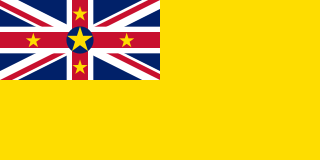
Niue is an island country in the South Pacific Ocean, 2,400 kilometres (1,500 mi) northeast of New Zealand, east of Tonga, south of Samoa, and west of the Cook Islands. Niue's land area is about 261 square kilometres (101 sq mi) and its population, predominantly Polynesian, was about 1,600 in 2016. The island is commonly referred to as "The Rock", which comes from the traditional name "Rock of Polynesia". Niue is one of the world's largest coral islands. The terrain of the island has two noticeable levels. The higher level is made up of a limestone cliff running along the coast, with a plateau in the centre of the island reaching approximately 60 metres high above sea level. The lower level is a coastal terrace approximately 0.5 km wide and about 25–27 metres high, which slopes down and meets the sea in small cliffs. A coral reef surrounds the island, with the only major break in the reef being in the central western coast, close to the capital, Alofi. A notable feature are the many limestone caves near the coast.

Oceania is a geographic region comprising Australasia, Melanesia, Micronesia and Polynesia. Spanning the eastern and western hemispheres, Oceania covers an area of 8,525,989 square kilometres (3,291,903 sq mi) and has a population of 40 million. Situated in the southeast of the Asia-Pacific region, Oceania, when compared to continental regions, is the smallest in land area and the second smallest in population after Antarctica.

Tokelau is a dependent territory of New Zealand in the southern Pacific Ocean. It consists of three tropical coral atolls, with a combined land area of 10 km2 (4 sq mi). The capital rotates yearly between the three atolls. Tokelau lies north of the Samoan Islands, east of Tuvalu, south of the Phoenix Islands, southwest of the more distant Line Islands, and northwest of the Cook Islands. Swains Island is geographically part of Tokelau, but is subject to an ongoing territorial dispute and is currently administered by the United States as part of American Samoa.

Zealand, at 7,031 km2, is the largest and most populous island in Denmark proper. Zealand has a population of 2,302,074.

The North Island, also officially named Te Ika-a-Māui, is one of the two main islands of New Zealand, separated from the larger but much less populous South Island by Cook Strait. The island's area is 113,729 square kilometres (43,911 sq mi), making it the world's 14th-largest island. It has a population of 3,749,200.

The South Island, also officially named Te Waipounamu, is the larger of the two major islands of New Zealand in surface area; the other being the smaller but more populous North Island. It is bordered to the north by Cook Strait, to the west by the Tasman Sea, and to the south and east by the Pacific Ocean. The South Island covers 150,437 square kilometres (58,084 sq mi), making it the world's 12th-largest island. It has a temperate climate.

The Chatham Islands form an archipelago in the Pacific Ocean about 800 kilometres (500 mi) east of the South Island of New Zealand. It consists of about ten islands within a 40-kilometre (25 mi) radius, the largest of which are Chatham Island and Pitt Island. Some of these islands, once cleared for farming, are now preserved as nature reserves to conserve some of the unique flora and fauna. The resident population is 600. The local economy is largely dependent on conservation, tourism, farming, and fishing.
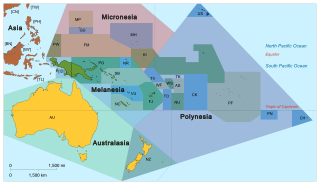
Pacific Islanders or Pasifikas, are the peoples of the Pacific Islands. It is a geographic and often ethnic/racial term to describe the inhabitants of any of the three major sub-regions of Oceania: Micronesia, Melanesia and Polynesia. These people speak various Austronesian languages. New Zealand has the largest concentration of Pacific Islanders in the world. However, the majority of its people are not identified as Pacific Islanders—instead during the 20th century and into the 21st century the country saw a steady stream of immigration from Polynesian countries such as Samoa, Tonga, the Cook Islands, Niue and French Polynesia.

The monarchy of New Zealand is the constitutional system of government in which a hereditary monarch is the sovereign and head of state of New Zealand. The current monarch, Queen Elizabeth II, ascended the throne on the death of her father, King George VI, on 6 February 1952.
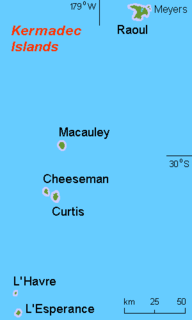
The Kermadec Islands are a subtropical island arc in the South Pacific Ocean 800–1,000 km (500–620 mi) northeast of New Zealand's North Island, and a similar distance southwest of Tonga. The islands are part of New Zealand, 33 km2 (12.7 sq mi) in total area and nowadays uninhabited, except for the permanently manned Raoul Island Station, the northernmost outpost of New Zealand.

The Realm of New Zealand is the entire area in which the Queen of New Zealand is head of state. The Realm of New Zealand is not a federation; it is a collection of states and territories united under its monarch. New Zealand is an independent and sovereign state. It has one Antarctic territorial claim, the Ross Dependency; one dependent territory, Tokelau; and two associated states, the Cook Islands and Niue.

New Zealand is a sovereign island country in the southwestern Pacific Ocean. The country geographically comprises two main landmasses—the North Island, and the South Island —and around 600 smaller islands. New Zealand is situated some 2,000 kilometres (1,200 mi) east of Australia across the Tasman Sea and roughly 1,000 kilometres (600 mi) south of the Pacific island areas of New Caledonia, Fiji, and Tonga. Because of its remoteness, it was one of the last lands to be settled by humans. During its long period of isolation, New Zealand developed a distinct biodiversity of animal, fungal, and plant life. The country's varied topography and its sharp mountain peaks, such as the Southern Alps, owe much to the tectonic uplift of land and volcanic eruptions. New Zealand's capital city is Wellington, while its most populous city is Auckland.

Periegops is a genus of spiders, the only genus in the family Periegopidae, with three described species. Periegops had been long considered to be members of Sicariidae or Segestriidae until Raymond Forster elevated them to the family level in 1995.

The Orsolobidae are a six-eyed spider family with about 180 described species in 29 genera. They were separated from the Dysderidae. Several genera were transferred from the Oonopidae.
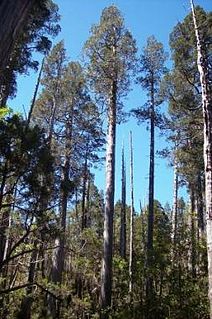
The Antarctic Floristic Kingdom, also the Holantarctic Kingdom, is a floristic kingdom. It includes most areas of the world south of 40°S latitude. It was first identified by botanist Ronald Good, and later by Armen Takhtajan. The Antarctic Floristic Kingdom is a classification in phytogeography, different from the Antarctic ecozone classification in biogeography, and from Antarctic flora genera/species classifications in botany.
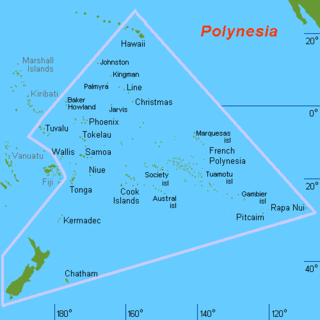
Polynesia is a subregion of Oceania, made up of more than 1,000 islands scattered over the central and southern Pacific Ocean. The indigenous people who inhabit the islands of Polynesia are termed Polynesians, and share many similar traits including language family, culture, and beliefs. Historically, they had a strong tradition of sailing and using stars to navigate at night. The largest country in Polynesia is New Zealand.

Cyclaxyra is a genus of cucujoid beetles in the family Cyclaxyridae. There are two described species in Cyclaxyra, found on the North Island, South Island, and Stewart Island of New Zealand.



















